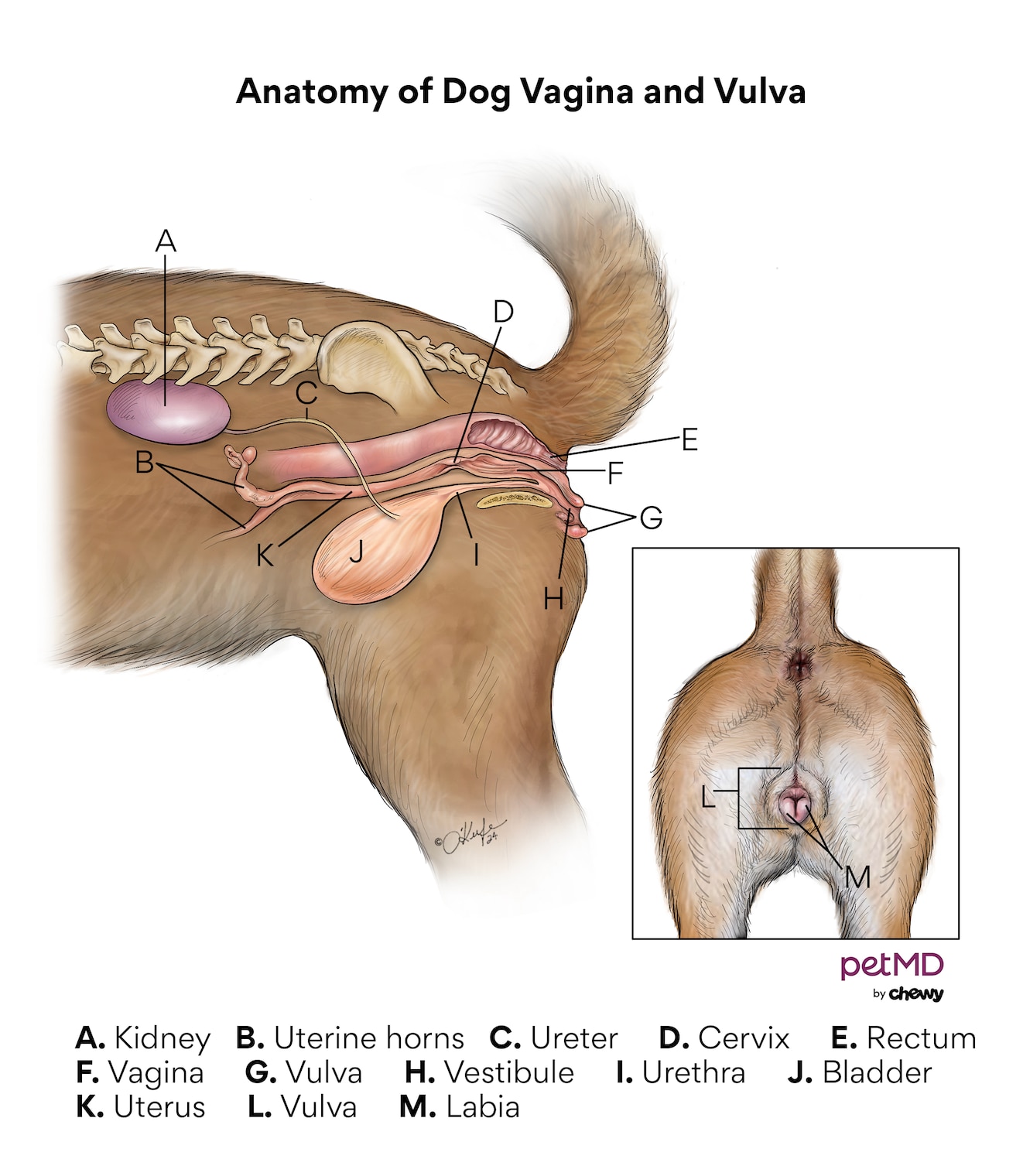Dog Vagina Health Guide: Everything You Need to Know
dageldog/iStock / Getty Images Plus via Getty Images
Every part of the body can be injured or affected by disease, and this includes a dog’s vagina. Symptoms involving the vagina are uncomfortable and may be signs of a potentially serious health condition.
This guide will help you determine what’s normal, when you should be worried about your dog’s vaginal health, and whether you need to call your veterinarian.
Anatomy of the Dog Vagina and Vulva
The outer portion of a female dog’s reproductive tract is called the vulva. It consists of two labia (thick folds of tissue) that are connected at the top and bottom.
The vestibule (continuation of the vagina) lies just inside of the vulvar opening. The vagina opens into the vestibule, as does the urethra (the tube that drains the bladder). The vagina then connects with the cervix and then on to the uterus.

Click here to download this medical illustration.
What Is Normal for a Healthy Dog Vagina?
To understand when something is wrong with your dog’s vagina, you need to know what a normal dog vagina looks like.
It’s normal to be able to see your dog’s vulva. If a female dog has not been spayed, the appearance of her vulva can change dramatically over the course of her heat cycle.
Many unspayed dogs will “spot” small amounts of blood before they go into a full cycle, so it’s not unusual to see light bleeding before she enters a true heat cycle.
When a dog is in heat (receptive to mating), her vulva becomes swollen, and a bloody discharge will be evident. Heat usually lasts for a week or two but can vary widely between dogs.
If your dog is in heat, you can use reusable dog diapers to keep your home from getting messy.
After being in heat, the bleeding should stop, and your dog’s vulva will return to its normal appearance. Dogs may go through this entire cycle once every four months to once every 12 months.
Common Dog Vagina Problems
Let's look at some of the most common vaginal issues in dogs.
Swollen Vulva in Dogs
If you need to spread the skin apart to see your dog’s vulva, there’s an issue. Extra skin around the vulva can cause urinary tract infections, vaginal infections, and dermatitis. Your dog may not even show any symptoms until an infection is advanced.
Depending on the extent of extra tissue, surgical removal of the extra skin may be necessary.
If your dog has a condition called vaginal hyperplasia, dark pink or red tissue may protrude from the vulva. The tissue swelling that causes this should resolve when the heat cycle ends. Spaying your dog will also take care of the problem and prevent future occurrences.
If your spayed female dog has a swollen vulva with a bloody discharge, it’s possible that some ovarian tissue remained within her abdomen after her spay surgery.
Infections, injuries, and tumors can also make a dog’s vulva appear to be swollen.
Call your vet if your dog’s vulva is swollen and you know that she isn’t in heat.
Vulvar Fold Dermatitis
Sometimes, when the skin around the vulva holds in moisture such as after urination or traps any debris, the skin around the vulva can become very irritated and uncomfortable and can even with time result in a urinary tract infection.
If your pup has an “inset vulva” which retains urine or other debris, regular cleaning is necessary to keep this area clean. Some severely affected dogs require surgery.
Bloody Discharge
Bloody discharge from the vulva is a normal part of an unspayed female dog’s heat cycle. Dogs typically go into heat and bleed between one to three times a year.
However, if your dog has been spayed or you know it is not time for your unspayed dog to go into heat, the bleeding could be a sign of a potentially serious health problem.
If you see blood coming from your dog’s vulva, it could be a result of:
-
Trauma
-
Tumors
-
Infections
-
Anatomic abnormalities
-
Blood clotting disorders
-
Conditions affecting the urinary tract
Your dog should be evaluated by a veterinarian unless she is known to be in heat and there aren’t any other issues.
Changes in Color
The outer surfaces of a dog’s labia are covered with skin and a small amount of hair, which should appear like the surrounding skin and hair.
Some dark staining may be present due to the presence of fluids—like saliva—that turn reddish-brown when exposed to air. The inner surfaces of the labia are a pink color but are not normally visible.
If you notice changes to the coloration of your dog’s vulva or surrounding tissues, or a discharge of any color, make an appointment with your veterinarian.
Abnormal Discharge
A dog who is in heat will have bloody discharge from her vulva, and a dark green to black discharge is normal in the days after a dog has given birth.
However, other types of discharges, which may be watery or bloody, or look like mucus or pus, are generally associated with health problems and warrant a trip to the veterinarian.
Possible diagnoses include:
-
Traumatic injury
-
Pregnancy and birth-related problems
-
Foreign material within the vagina
-
Infection of the urinary or reproductive tract, including a potential fatal uterine infection called pyometra
-
Urinary tract stones
-
Blood clotting disorders
-
Anatomic abnormalities (such as an inset vulva)
-
Hormonal disorders
There should also be little to no odor associated with a dog’s vulva, so if you smell or see anything unusual in this area, make an appointment with your veterinarian.
Dog Licking Her Vagina Excessively
A dog will sometimes lick her vulva to help keep it clean.
Intermittent licking is rarely a problem unless you also notice a vaginal discharge or changes in the vulva’s appearance, her overall health has worsened, or the licking becomes more frequent or intense.
Excessive licking can be a sign of infection, injuries, or other problems with your dog’s urinary or reproductive tract. Call your veterinarian if you notice that your pup is licking themselves excessively.
Rash Around the Vagina
The skin that surrounds a dog’s vulva can develop rashes just like any other area of the body.
Because the vulva touches the ground whenever a dog sits, it frequently encounters irritants, allergens, and insects that may bite. Parasites or skin infections can also cause rashes around a dog’s vulva.
A bath using cool water and a gentle soap might help if your dog’s rash developed due to contact with an allergen or irritant.
Rashes that are severe, produce significant discomfort, or persist for more than a day or two should be evaluated by your veterinarian.
Vagina Has Lump, Bump, or Growth
Lumps, bumps, or growths that are in or around a dog’s vulva are not normal and may be associated with:
-
Injuries
-
Infections
-
Inflammation
-
Cysts
-
Tumors
Dogs who have not been spayed may develop vaginal hyperplasia.
The tissue swelling that causes this should resolve when your dog goes out of heat or when she is spayed. If the tissue around your dog’s vulva appears swollen and she is not currently in heat, it is time to schedule a checkup.
Does My Dog Have Vaginitis?
Pet parents often worry that their dog might have vaginitis. Symptoms of vaginitis in dogs include:
-
Discharge from the vulva
-
Licking the vulva
-
Male dogs may show sexual interest even if a female dog is not in heat
What Causes Dog Vaginitis?
Vaginitis can have a variety of causes. Sometimes bacteria or other pathogens are solely to blame, but in other cases, inflammation develops because of other health problems.
The following problems can all lead to vaginitis in dogs:
-
Vaginal trauma
-
Foreign bodies
-
Anatomic abnormalities
-
Tumors
-
Problems with the urinary tract
-
Hormonal disorders
Can Puppies Get Vaginitis?
Puppies who have not gone through a heat cycle can develop a condition called puppy vaginitis that has symptoms like the ones listed above. Puppies will outgrow vaginitis in almost all cases.
